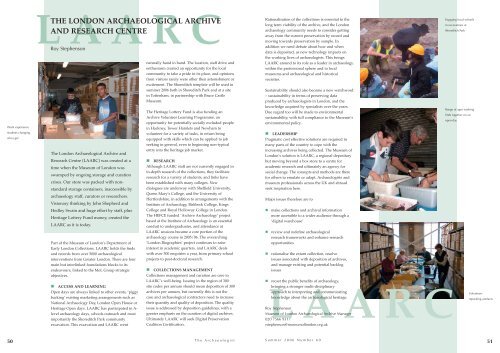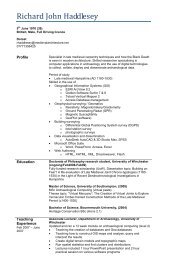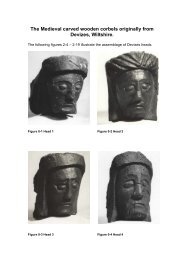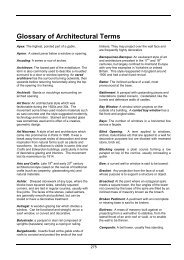The ARCHAEOLOGIST - English Late-Medieval timber-framed ...
The ARCHAEOLOGIST - English Late-Medieval timber-framed ...
The ARCHAEOLOGIST - English Late-Medieval timber-framed ...
You also want an ePaper? Increase the reach of your titles
YUMPU automatically turns print PDFs into web optimized ePapers that Google loves.
Work experience<br />
students changing<br />
silica gel<br />
LAARC<br />
THE LONDON ARCHAEOLOGICAL ARCHIVE<br />
AND RESEARCH CENTRE<br />
Roy Stephenson<br />
<strong>The</strong> London Archaeological Archive and<br />
Research Centre (LAARC) was created at a<br />
time when the Museum of London was<br />
swamped by ongoing storage and curation<br />
crises. Our store was packed with nonstandard<br />
storage containers, inaccessible by<br />
archaeology staff, curators or researchers.<br />
Visionary thinking by John Shepherd and<br />
Hedley Swain and huge effort by staff, plus<br />
Heritage Lottery Fund money, created the<br />
LAARC as it is today.<br />
Part of the Museum of London’s Department of<br />
Early London Collections, LAARC holds the finds<br />
and records from over 5000 archaeological<br />
interventions from Greater London. <strong>The</strong>re are four<br />
main but interlinked foundations blocks to its<br />
endeavours, linked to the MoL Group strategic<br />
objectives.<br />
ACCESS AND LEARNING<br />
Open days are always linked to other events, ‘piggy<br />
backing’ existing marketing arrangements such as<br />
National Archaeology Day, London Open House or<br />
Heritage Open days. LAARC has participated in A-<br />
level archaeology days, schools outreach and most<br />
importantly the Shoreditch Park community<br />
excavation. This excavation and LAARC went<br />
naturally hand in hand. <strong>The</strong> location, staff drive and<br />
enthusiasm created an opportunity for the local<br />
community to take a pride in its place, and opinions<br />
from visitors rarely were other then astonishment or<br />
excitement. <strong>The</strong> Shoreditch template will be used in<br />
summer 2006 both in Shoreditch Park and at a site<br />
in Tottenham, in partnership with Bruce Castle<br />
Museum.<br />
<strong>The</strong> Heritage Lottery Fund is also funding an<br />
Archive Volunteer Learning Programme, an<br />
opportunity for potentially socially excluded people<br />
in Hackney, Tower Hamlets and Newham to<br />
volunteer for a variety of tasks, in return being<br />
equipped with skills which can be applied to job<br />
seeking in general, even to beginning non-typical<br />
entry into the heritage job market.<br />
RESEARCH<br />
Although LAARC staff are not currently engaged in<br />
in-depth research of the collections, they facilitate<br />
research for a variety of students, and links have<br />
been established with many colleges. New<br />
dialogues are underway with Sheffield University,<br />
Queen Mary’s College, and the University of<br />
Hertfordshire, in addition to arrangements with the<br />
Institute of Archaeology, Birkbeck College, Kings<br />
College and Royal Holloway College in London.<br />
<strong>The</strong> HEFCE funded ‘Archive Archaeology’ project<br />
based at the Institute of Archaeology is an essential<br />
conduit to undergraduates, and attendance at<br />
LAARC sessions became a core portion of the<br />
archaeology course in 2005/06. <strong>The</strong> overarching<br />
‘London Biographies’ project continues to raise<br />
interest in academic quarters, and LAARC deals<br />
with over 500 enquiries a year, from primary school<br />
projects to post-doctoral research.<br />
COLLECTIONS MANAGEMENT<br />
Collections management and curation are core to<br />
LAARC’s well-being. Issuing in the region of 300<br />
site codes per annum should mean deposition of 300<br />
archives per annum, but currently this is not the<br />
case and archaeological contractors need to increase<br />
their quantity and quality of deposition. <strong>The</strong> quality<br />
issue is addressed by deposition guidelines, with a<br />
greater emphasis on the curation of digital archives.<br />
Ultimately LAARC will seek Digital Preservation<br />
Coalition Certification.<br />
Rationalisation of the collections is essential to the<br />
long term viability of the archive, and the London<br />
archaeology community needs to consider getting<br />
away from the current preservation by record and<br />
moving towards preservation by sample. In<br />
addition we need debate about how and when<br />
data is deposited, as new technology impacts on<br />
the working lives of archaeologists. This brings<br />
LAARC around to its role as a leader in archaeology,<br />
within the professional sphere and to local<br />
museums and archaeological and historical<br />
societies.<br />
Sustainability should also become a new watchword<br />
– sustainability in terms of preserving data<br />
produced by archaeologists in London, and the<br />
knowledge acquired by specialists over the years.<br />
Due regard too will be made to environmental<br />
sustainability, with full compliance to the Museum’s<br />
environmental policy.<br />
LEADERSHIP<br />
Pragmatic cost effective solutions are required in<br />
many parts of the country to cope with the<br />
increasing archives being collected. <strong>The</strong> Museum of<br />
London’s solution is LAARC, a regional depositary<br />
but moving beyond a box store to a centre for<br />
academic research and ultimately an agency for<br />
social change. <strong>The</strong> concepts and methods are there<br />
for others to emulate or adapt. Archaeologists and<br />
museum professionals across the UK and abroad<br />
seek inspiration here.<br />
Major issues therefore are to<br />
<br />
<br />
<br />
make collections and archival information<br />
more accessible to a wider audience through a<br />
‘digital warehouse’<br />
review and redefine archaeological<br />
research frameworks and enhance research<br />
opportunities<br />
rationalise the extant collection, resolve<br />
issues associated with deposition of archives,<br />
and manage existing and potential backlog<br />
issues<br />
<br />
LAARC<br />
recast the public benefits of archaeology,<br />
bringing a stronger multi-disciplinary<br />
approach to interpreting and communicating<br />
knowledge about the archaeological heritage.<br />
Roy Stephenson<br />
Museum of London Archaeological Archive Manager<br />
020 7566 9317<br />
rstephenson@museumoflondon.org.uk<br />
Engaging local schools<br />
in excavations at<br />
Shoreditch Park<br />
Range of ages washing<br />
finds together on an<br />
open day<br />
Volunteers<br />
repacking artefacts<br />
50<br />
<strong>The</strong> Archaeologist<br />
Summer 2006 Number 60<br />
51





